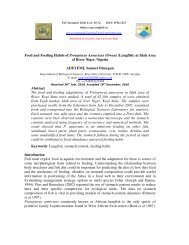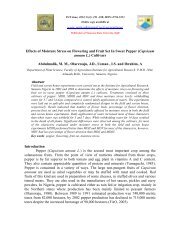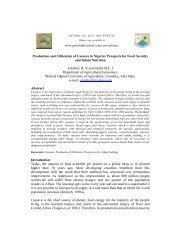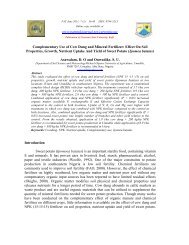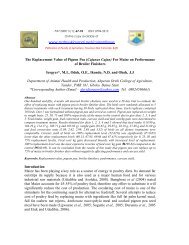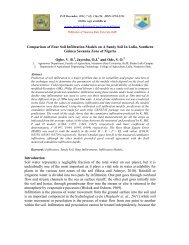View Publication - Production Agriculture and Technology Journal
View Publication - Production Agriculture and Technology Journal
View Publication - Production Agriculture and Technology Journal
Create successful ePaper yourself
Turn your PDF publications into a flip-book with our unique Google optimized e-Paper software.
PAT December, 2012; 8 (2): 59-67 ISSN: 0794-5213Online copy available atwww.patnsukjournal.net/currentissue<strong>Publication</strong> of Nasarawa State University, KeffiCost <strong>and</strong> Returns of Cowpea Enterprise In Lafia Local Government of NasarawaState, Nigeria.Abah, D <strong>and</strong> Tor, I.. EDepartment of Agricultural Extension <strong>and</strong> Management, College of <strong>Agriculture</strong>, LafiaDepartment of Agribusiness, University of <strong>Agriculture</strong>, Makurdidangod23@yahoo.comAbstractThe study was conducted to evaluate the costs <strong>and</strong> returns to cowpea enterprise <strong>and</strong> examinetheir constraints in Lafia Local Government Area, Nasarawa State of Nigeria. Sixty cowpeafarmers were selected through purposive sampling of the population <strong>and</strong> structuralquestionnaires were used to collect the data. Data were analysed using descriptive statistics<strong>and</strong> gross margin analysis. Results show that most (75%) of the farmers were female <strong>and</strong>within the active age of 20 <strong>and</strong> above. About 13% of them had no formal education, while 87%have one form of education or the other. The gross margin for average output ofcowpea/hectare is ₦39,983.77, the gross return per hectare was ₦64,980.55 while the totalvariable cost was ₦24,996.55. Inadequate fund was ranked the highest constraint faced bycowpea farmers in the study area. It was therefore, recommended that cowpea enterpriseshould be encouraged into the enterprise because it is a profitable enterprise.Keywords; Cowpea Enterprise, Cost <strong>and</strong> return, constraintsIntroductionCowpea is one of the most ancient crops known to man. Its origin <strong>and</strong> subsequentdomestication is associated with pearl millet <strong>and</strong> sorghum in Africa. It is now a broadlyadapted <strong>and</strong> highly valued crop, cultivated around the world primarily for seed, butalso as a vegetable (for leafy greens, green pods, fresh shelled green peas, <strong>and</strong> shelleddried peas), a cover crop <strong>and</strong> for fodder. Cowpea is considered more tolerant to droughtthan soybeans <strong>and</strong> better adapted to s<strong>and</strong>y soils. Many cowpea cultivars have a vininggrowth habit, but modern plant breeding has also led to more upright, bush-typecultivars. There are cowpea breeding programs throughout the primary productionareas, which include Arkansas, California, Texas <strong>and</strong> southeastern states. Yieldinformation is available on the varieties released from these programs (Dugje, et al2009). According to Dugje et al (2009), Cowpeas are an under-utilized indigenouscrop, which have many advantages for both small-scale <strong>and</strong> commercial farmers. As afood for humans, cowpeas can be used as a spinach, green bean, protein-rich seed, meator coffee substitute. For livestock, cowpeas can be used as grazing, or baled for hay orsilage. Cowpeas are also an excellent cover crop <strong>and</strong> soil improver since they addnitrogen to the soil <strong>and</strong> improve soil structure.
PAT 2012; 8 (2):59–67: ISSN: 0794-5213; Abah <strong>and</strong> Tor: Cost <strong>and</strong> Returns of Cowpea Enterprise ….… 60Cowpea grow best in hot areas <strong>and</strong> can produce a yield of 1 ton seed <strong>and</strong> 5 ton hay/hawith as little as 300 mm of rainfall. One of the biggest advantages of the cowpea is itsexcellent drought tolerance; this is achieved by long tap roots <strong>and</strong> the plants is beingable to restrict water use by mechanisms such as turning the leaves upwards to preventthem getting too hot <strong>and</strong> closing the stomataThe annual global cowpea grain production is estimated at 3 million (Singh et. al,1997). Approximately 64% of this grows in west <strong>and</strong> central Africa, which account for80% of total production in Africa. In Africa cowpea provides sources of income forwomen farmers who produce, make <strong>and</strong> sell snack foods from this nutritious legume. InNigeria the production trend of cowpea has experienced about 44.1% increase in areaplanted <strong>and</strong> 41.% increase in yield from 1961 to 1995 (Ortiz 1998). According toInaizume et.al (1999) several factors account for the impressive significant advancesmade by International Institution of Tropical <strong>Agriculture</strong> (IITA) over the last twodecade in improving cowpea productivity in Sub - Saharan Africa. Singh et al (1994)also indicated that a number of varieties have been developed which combine diverseplant type, different maturity period, <strong>and</strong> resistance to several disease, insect pest <strong>and</strong>parasite as well as good agronomic traits . Economically, cowpea has a great value inthe internals trade in country because it promotes trade between the production area <strong>and</strong>non producing area. It also serves as a source of income for middlemen who embark ontransportation from one place: to another. If production potentials will be properlyharnessed in the study area, it will improved the livelihood <strong>and</strong> st<strong>and</strong>ard of living of thepeople in the area.Cowpea is an important crop in the international market. It can be transformed into somany forms, in several dishes in many houses. It is also a significant source of vitamins.Despite its importance; there is still the insufficiency of the crop due to some problem,that hinder its productivity, such as abiotic, biotic, socio economic, socio- cultural <strong>and</strong>political factors. The abiotic factors include erratic rainfall, high soil temperature, lowsoil fertility, the Biotic factors are insect pest, parasitic weed, disease induced by fungi,viruses <strong>and</strong> nematodes. The socioeconomic factors: include farmers in capacity toproduce, limited input <strong>and</strong> poor input delivery systems. The socio-cultural factors arelow acceptability of cowpea, low acceptance of new formulation of chemicals <strong>and</strong>improve post-harvest technologies. The political factors include negative or neglectedposition of the developing countries government to restore the problems associated withdevelopment of post-harvest systems (Singh et. al, 1997). The study was conducted toexamine the cost <strong>and</strong> returns of cowpea enterprise in the study area but specifically, theobjectives were to describe the socio-economic characteristics of cowpea enterprise,determine costs <strong>and</strong> returns in cowpea production <strong>and</strong> identify constraints in cowpeaproduction.
PAT 2012; 8 (2):59–67: ISSN: 0794-5213; Abah <strong>and</strong> Tor: Cost <strong>and</strong> Returns of Cowpea Enterprise ….… 65farmers in the study area. The study revealed that 83.3% of the farmers were faced withthis problem. This implies that some of the farmers were able to acquire chemical <strong>and</strong>the high cost of chemical affected the total variable cost.Weed Control ProblemThe result of the study indicated weed control problem as the fourth rankedproblem encountered by the farmers in the study area. The result revealed that 75.0% ofthem were faced with this problem; this implies that weed is a challenge to cowpeaproduction <strong>and</strong> this had negative effect on production because it increased costs oflabour <strong>and</strong> equally affected the performance of cowpea production in the study area.Table 2: Respondents Response on Constraints For Cowpea <strong>Production</strong> In NasarawaStateConstraint Frequency* Percentage* RankInadequate fund 58 96.7 1High cost of fertilizer 54 90.0 2High cost of chemical 50 83.3 3Weed control problem 45 75.0 4Inadequate improved seedInadequate labour supply403866.763.356High cost of seed 36 60.0 7Inadequate extension contact 34 56.7 8Source: Field Survey, 2011 * Multiple responsesCost <strong>and</strong> Return Analysis of Cowpea <strong>Production</strong>.Cost <strong>and</strong> return analysis was undertaken to determine the gross margin ofcowpea farmers in Lafia Local Government Area of Nasarawa State. Table 3 revealedthat on the average the gross margin is 39,983.37 per hectare, the total Variable Costis 24,996.55per hectare while the Total Revenue is 64980.34 per hectare. Thisimplies that the total revenue is greater than the total variable cost which indicates thatthere was significant gross margin in cowpea production <strong>and</strong> the enterprise is profitable.The result also shows that cost of hired labour account for (29.25%) highest of the totalcost in cowpea production with estimated cost of 7310.50 per hectare. This shows thatthe farmers spent more on hired labour than other inputs,that implies that if familylabour can be use for the production process, variable cost will reduce <strong>and</strong> gross marginwill increase. While cost of seed incurred less which accounted (4.90%) of the total costof cowpea production.
PAT 2012; 8 (2):59–67: ISSN: 0794-5213; Abah <strong>and</strong> Tor: Cost <strong>and</strong> Returns of Cowpea Enterprise ….… 66Table 3: Cost <strong>and</strong> Return Analysis of RespondentVariable Cost(N) PercentageCost of Seed X1 1,225.10 4.90Cost of L<strong>and</strong> X2 2,100.05 8.40Cost of Family Labour X3 2,510.30 10.04Cost of Hired Labour X4 7,310.50 29.25Cost of Fertilizer X56,200.5024.81Cost of Chemical X63,150.5012.60Cost of Mechanization X7 2,450.10 9.80Total Variable CostTotal Revenue24996.5564980.34Source: Field Survey, 2011. GM = TR TVC N64,980.34 N24,996.55 GM= N39,983.79ConclusionCowpea enterprise is quite profitable with high gross margin <strong>and</strong> the enterprise iseasy to start with low initial capital. The study review that labour is the highest variablecost incurred. The major constraints faced by cowpea farmers are inadequate funds <strong>and</strong>high cost costs of inputs. Cowpea enterprise is dominated by men in the study area <strong>and</strong>majority of them are within their active age.RecommendationBased on the research findings the following are recommended. There is need forprovision of basic production inputs at subsidized rate such as fertilizer, chemicals <strong>and</strong>credit facilities whichwill eventually enhance production <strong>and</strong>. Policies aimed at increasing total productionthrough genetic improvement should be made.ReferencesAbu, G.A. (2007). Comparative Analysis of Resource use Efficiency betweenparticipant <strong>and</strong> non participant farmers in the special crop programme in BenueState, Nigeria. Unpublished PhD thesis, Department of Agricultural Economics,Ahmadu Bello University, Zaria.Dugje, I.Y., L.O. Omoigui, F Ekeleme, A.Y. Kamara, <strong>and</strong>H. Ajeigbe.( 2009)Farmers Guide to Cowpea <strong>Production</strong> in West Africa.IITA, Ibadan,Nigeria. 20pInailizume, H; Singh, B.B., Sanginga, P.C. Manyong, ML, Adesina, A.A. <strong>and</strong>Tarrawali, S. (1999); Adoption <strong>and</strong> Impact of dry - season Dual - purpose
PAT 2012; 8 (2):59–67: ISSN: 0794-5213; Abah <strong>and</strong> Tor: Cost <strong>and</strong> Returns of Cowpea Enterprise ….… 67Cowpea in the semi arid zone of Nigeria. HTA, Ibadan, Nigeria, pp.16(available also at www. Hta.org/ info/impact/Cowpea. PDF)Njoku, J.E. (1991). Factors Influencing the Adoption of Improve Oil Palm productionTechnologies by Small Holders in Imo State, Nigeria in: Olukosi, J.O.,Ogungbile, A.O. <strong>and</strong> Kalu, B.A (eds). Appropriate Agricultural Technologiesfor Research’s Poor Farmers. Pp.207-218.NPC (2006). National Population Commission 2006 Figure..Nasarawa StateGovernment (2006). Ministry of Information, Lafia annual report.Ortiz. R. 1998. Cowpeas from Nigeria. A Silent food rotation outlook on <strong>Agriculture</strong> 27(2), 125.Otunosin, S.O. (1986). Modern aquaculture practice for increased fish production inNigeria, in the proceedings of the 4 th Annual Conference of the FisheriesSociety of Nigeria, Port-Harcourt Nigeria, 26 th 29 th November, Pp89-104Singh, B.B., D.R. Mohan Raj, K.E. Dashiell, <strong>and</strong> L.E.N. Jackai (1997). Advances inCowpea Research. Copublication of IITA <strong>and</strong> Japan International ResearchCentre for Agricultural Sciences (JIRCAS). IITA, Ibadan, Nigeria.Yusuf, O. (2005). Economics Analysis of Egusi Melon production in Okehi LocalGovernment Area of Kogi State, M.Sc. Thesis, Department of AgriculturalEconomics <strong>and</strong> Rural Sociology, Ahmadu Bello University, Zaria, 41- 48Pp.



